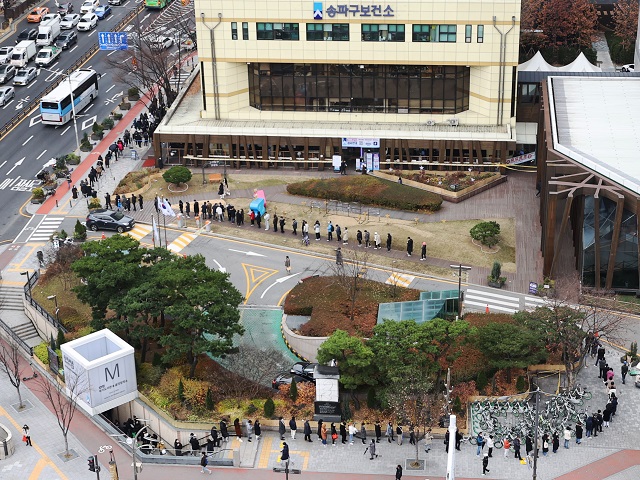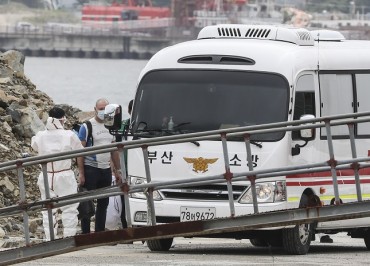
The graphic showing the daily coronavirus infection cases is on display at a testing center in the southwestern city of Gwangju on Dec. 9, 2021. (Yonhap)
SEOUL, Dec. 10 (Korea Bizwire) — South Korea’s new coronavirus cases stayed above 7,000 for the third consecutive day Friday and its caseload surpassed the grim milestone of 500,000 as the coronavirus continued to spread unabated among the unvaccinated and older adults with waning immunity.
The country reported 7,022 new COVID-19 infections, raising the total caseload to 503,606, according to the Korea Disease Control and Prevention Agency (KDCA).
The figure was the third highest daily total of the pandemic, after a record-high of 7,174 reported Wednesday and 7,102 the previous day.
Of the total, Seoul reported 2,800 new cases, while 2,030 cases came from the surrounding Gyeonggi Province and 465 from Incheon, 40 kilometers west of Seoul.
The number of critically ill COVID-19 patients came to 852, the second-highest after 857 reported Thursday, putting increasing strain on hospitals and intensive care units.
As of 5 p.m. Thursday, intensive care unit beds in the greater Seoul area were 85.4 percent full, up 0.4 percentage point from a day earlier.
A total of 1,258 patients were waiting to get admitted to hospitals. Of them, 285 had been waiting for beds for more than four days.
As of 12 a.m. Friday, 20,458 patients, including 9,866 Seoul citizens, had been treated for COVID-19 at home.
The death toll rose 53 to 4,130, the authorities said. The fatality rate stood at 0.82 percent.
As of 9 p.m. Friday, health authorities had reported 5,155 new cases, down 648 from the same time Thursday. Daily cases are tallied until midnight and announced the following morning.
Daily infections are expected to reach around 6,000 cases Saturday.
Earlier this week, the government implemented tightened health protocols to contain a rapid winter surge in infections, putting a brake on its plan to bring the country to a gradual return to normalcy.
Private gathering is limited and more businesses need to require patrons to show that they are fully vaccinated or have tested negative for the coronavirus. The measures will remain in effect until Jan. 2.
The authorities said the measures will start to show effects later this week, but health experts warned more stringent measures are needed to slow down the spread of the virus and the omicron variant.

A line of people waiting to get tested for the coronavirus stretches down into a subway station in eastern Seoul on Dec. 10, 2021. (Yonhap)
The KDCA reported three more cases of the omicron variant, bringing the total tally to 63 — 15 imported cases and 48 locally transmitted ones.
Most of the cases were linked to a church in Incheon where a pastor, the country’s first known omicron infection case, works. The pastor and his wife were confirmed to have been infected with the variant upon their return from a trip to Nigeria last month.
To shore up vaccine effectiveness, the government said it will cut the dosage interval between primary vaccination and booster shots to three months from the current 4-5 months.
“Our medical response capability is quickly burning out as daily cases remained in the 7,000s for the third day in a row with seniors aged 60 or older accounting for 35 percent of the cases,” Prime Minister Kim Boo-kyum said during a daily pandemic response meeting Friday.
“Our top priority is the swift administration of vaccines.”
On the vaccination front, 83.5 percent of the country’s 52 million population have received at least one shot of the vaccine, while 81 percent have received two shots and 10.3 percent have gotten their booster shots.
The government also issued an administrative directive of ordering hospitals nationwide to earmark more beds for COVID-19 patients, the fourth of its kind since the pandemic started early last year.
With the directive, the government expected to secure an additional 1,899 beds from 165 hospitals.
“We urgently need hospital beds to treat critically ill patients, which are rising at an alarming rate,” Kim said, adding that “the government will be left with no option but to implement stronger social distancing measures in the near term” if the current surge continues.
To tackle rising infection rates among teenagers, the government plans to run visiting vaccination services at schools starting next week, the prime minister said.
“The government will share accurate information and scientific evidence regarding vaccinations,” he said of COVID-19 vaccine skepticism, promising to provide special attention to any side effects in children or young adults.
(Yonhap)






